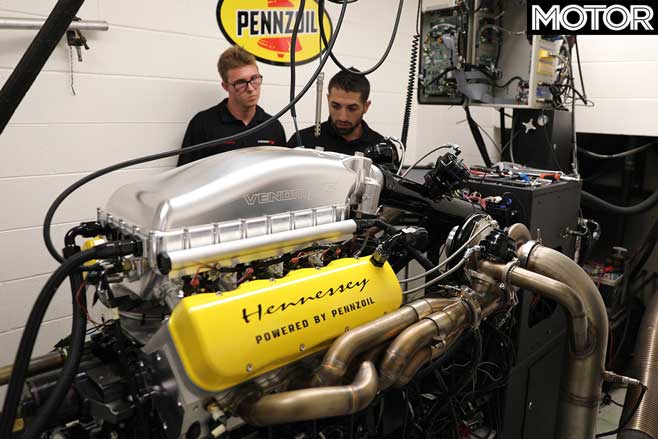This is an engine built to beat Bugatti. Called ‘Fury’, it is an insanely powerful twin-turbocharged V8 set to power what Hennessey Performance hopes will be the world’s fastest road car.
The Texas-based company is bolting Fury into its incoming Venom F5, an all-new hypercar that company founder John Hennessey originally promised would have more than 1193kW and a power-to-weight ratio of 892kW per tonne.

Turns out he was being conservative. During recent certification on an engine dyno, it actually produced a staggering 1355kW at 8000rpm and 1617Nm at 5500rpm.
Hennessey also shared full details on the engine, revealing Fury is based on a General Motors LS V8. Yep, this 1300kW-plus monster is a pushrod. It also explains why Fury has the same 104.8mm cylinder bore as an LS7.
Hennessey’s engineers reduced the piston stroke to 95.25mm, lifting the oversquare ratio to help it rev all the way to an 8200rpm redline.

This means a smaller 6.6-litre swept capacity for Fury, but now that it can pump more air through its lungs Hennessey remedies the loss in displacement and any bottom-end torque with a pair of ceramic-coated Precision turbochargers. And these are serious items.
Each cylinder bank feeds one with a 76mm compressor wheel that can supply enough air for a 1000kW engine. Your regular Subaru WRX STI features a 53mm-sized turbocharger compressor wheel.
Precision, an American company, has gone as far as designing a 3D-printed titanium compressor housing for each turbocharger. They pump 23psi worth of air into two throttle bodies bolted to a gleaming billet aluminium intake manifold that sits atop Fury’s vee. That air then pushes down through a water-cooled intercooler sandwiched between the intake chamber and lower runners.

Hennessey has done a lot of work strengthening Fury’s structural foundations for the tremendous torque on offer. Forged and billet steel abounds, with everything labelled ‘extreme duty’. The pistons, connecting rods, rod bolts and engine block are made from the former, while the crankshaft, main caps, pushrods and camshaft are from billet steel. The exhaust valves are made from Inconel, an F1-grade lightweight material, and the dry-sump oil pan is billet aluminium.
After leaving the engine’s output shaft, all that grunt meets a seven-speed single-clutch automatic transmission before going to the rear wheels.
And as for what the Fury’s power curves look like, Hennessey claims it will posses otherworldly punch from low in the rev range, with 1356Nm available from as little as 2000rpm.

As outstanding as these figures are, the F5 will certainly need an edge. Although John Hennessey hoped it would be the first road car to hit 300mph (482.8km/h), Bugatti’s Chiron Super Sport 300+ recently beat him to it. But, as he says, Bugatti did not complete the run in two directions, leaving the official record up for grabs.
Grab your popcorn, this high-speed battle is going to get very interesting.
In Detail

01 – As well as blow-off valves, two 90mm throttle bodies control flow into the intake manifold. Underneath the intercooler lies a second manifold that holds cooled air. It then goes into individual runners before being sprayed by two port-mounted injectors.
02 – Hennessey sets the compression ratio at 10.0:1. Meanwhile, its high-flow cylinder heads use dual valve springs to sustain the extreme load they’ll be under. For further strength, each cylinder main cap features six bolts.
03 – A four-stage dry-sump oiling system is essential for a car of such high performance, keeping fresh 10W60 synthetic motor oil flowing to the right places under high g loads and allowing a lower-mounted engine in the F5’s carbonfibre tub.
04 – The exhaust system has been designed to be as efficient as possible. Long runner tubes collect at a single point before gases, controlled by an external wastegate, dump into 3.0-inch downpipes that eventually meet a 3.5-inch titanium exhaust system.
Eye on the prize

The current record for the world’s fastest production car belongs to the Koenigsegg Agera RS at 277.87mph (446.97km/h) – the average of two runs in both directions. That’s what Hennessey wants to beat with its USD$1.6m F5. The prospects look good.
The F5 makes more grunt than the 1015kW/1370Nm Agera RS and weighs 56kg less at 1338kg. Meanwhile, it shares the same 0.33 drag coefficient. As for tyres, only Michelin has proven 300mph-plus road tyres (on the Bugatti Chiron SS 300), but Hennessey is yet to announce a supplier.






